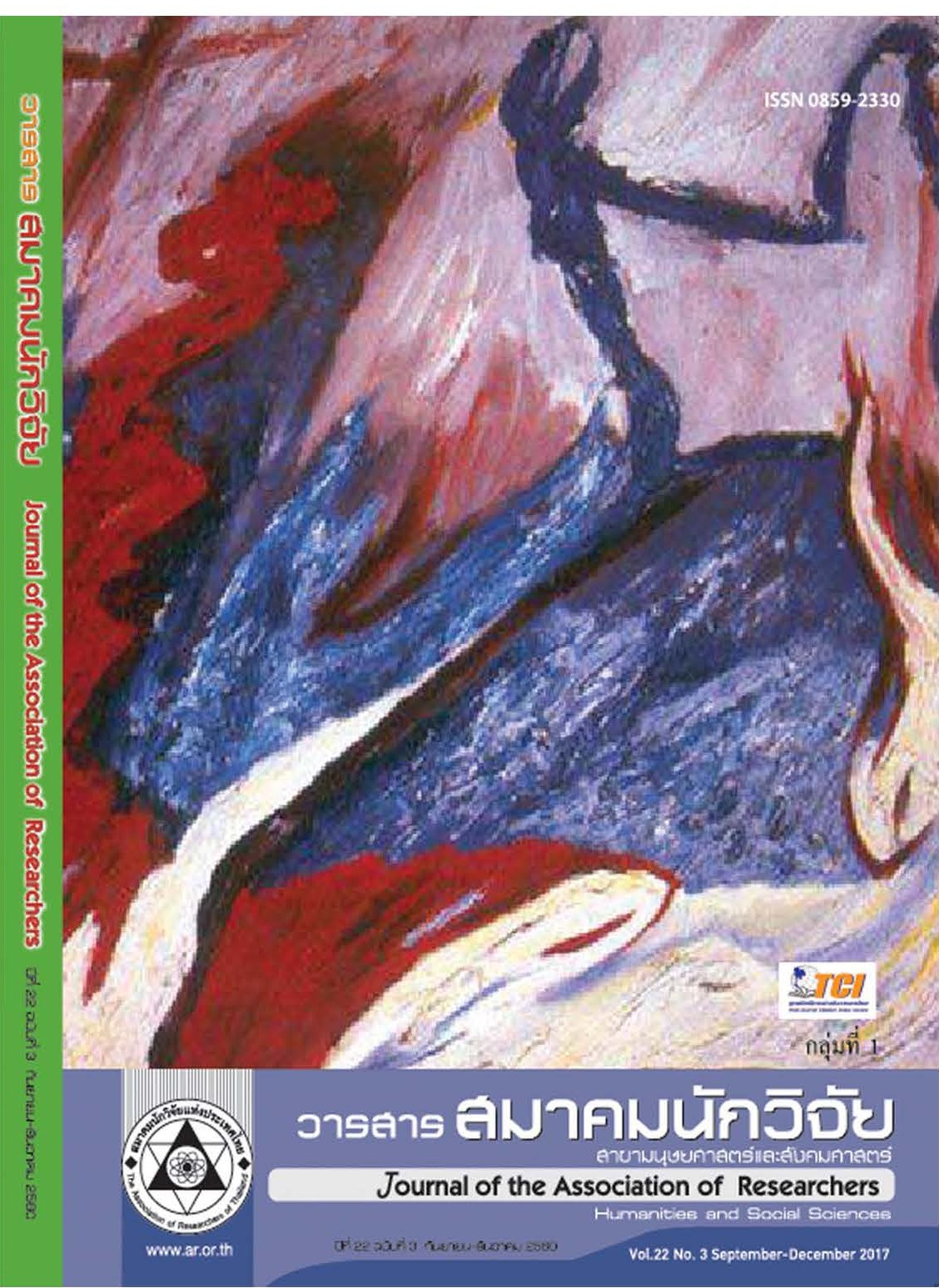The Components and Development of Information Technology Competencies of Primary School Teachers in Education Expansion Schools under Sa Kaeo Primary Education Service Area Office 1
Main Article Content
Abstract
no purpose of this research was to study the level of, components of, and guidelines for the development of information technology competencies of primary school teachers in education expansion schools under Sa Kaeo Primary Education Service Area Office 1 in Sa Kaeo province. The research sample for a quantitative study consisted of 400 primary school teachers working during the 2017 academic year in education expansion schools under Sa Kaeo Primary Education Service Area Office 1 in Sa Kaeo province. The research informants for the qualitative study were five experts and 10 stakeholders. The employed research instruments were a 5-scale rating questionnaire containing 25 items with a total reliability coefficient of 958, an in-depth interview form, and a form containing guidelines for focus group discussion. Data were analyzed with descriptive statistics, second-order confirmatory factor analysis techniques, and content analysis. Research findings showed that the information technology competencies of the teachers were at a moderate level (rating mean = 2.82). The model of components of information technology
competencies of the teachers conformed to empirical data (Chi-square = 439.66, df = 249, p-value = .000, Chi-Square di = 1.76; RMSEA = 047; RMR = 040; SRAME = .038; CFl= 99; GFI = 91; AGFI = 0; CN = 234.44). The model was composed of five main components, namely, data integration, data processing, creating information, data access, and data evaluation. As for guidelines for the development of information technology competencies of the teachers, there were three strategies as follows: (1) the strategy for the development of the basic structure of information technology at the school level; (2) the strategy for the development of the environment and learning community on information technology in instructional management in school; and (3) the strategy for monitoring and evaluation of information technology competencies by Sa Kaeo Primary Education Service Area Office 1 in Sa Kaeo province.
Article Details
บทความที่ปรากฏในวารสารนี้ เป็นความรับผิดชอบของผู้เขียน ซึ่งสมาคมนักวิจัยไม่จำเป็นต้องเห็นด้วยเสมอไป การนำเสนอผลงานวิจัยและบทความในวารสารนี้ไปเผยแพร่สามารถกระทำได้ โดยระบุแหล่งอ้างอิงจาก "วารสารสมาคมนักวิจัย"
References
กระทรวงศึกษาธิการ. (2554). แผนแม่บทเทคโนโลยีสารสนเทศและการสื่อสาร พ.ศ. 2550-2554 สืบค้นเมื่อ มีนาคม 1 2554, จาก http://www.nng.go.th
ณัฏฐา ผิวมา, ปริศนา มัชฌิมา และสายสุดา ป็นตระกูล. (2559), แนวทางการพัฒนาสมรรถนะด้านเทคโนโลยีสารสนเทศ- สําหรับนักศึกษามหาวิทยาลัยสวนดุสิต. วารสารปัญญาภิวัฒน์, 8, 234 – 217.
สมชาย เทพแสง. (2551). กลยุทธ์ของผู้นําการศึกษา กรุงเทพฯ: ภาควิชาการบริหารการศึกษามหาวิทยาลัยศรีนครินทรวิโรฒ
สุทธนู ศรีใส่ย์. (2551). หลักการนิเทศการศึกษา, กรุงเทพฯ : โรงพิมพ์จุฬาลงกรณ์มหาวิทยาลัย
อุษา บิกกินส์. (2555). การรู้เท่าทันสื่อและสารสนเทศ. สุทธิปริทัศน์, 26(80), 147 - 161
อุบลรัตน์ หริณวรรณ, กานดา พูนลาภทวี, ธีรพงษ์ วิริยานนท์ และกรรณ จรรยาวุฒิวรรณ์. (2557). สมรรถนะด้านเทคโนโลยีสารสนเทศทางการศึกษาของคร. วารสารวิชาการศึกษาศาสตร์ คณะศึกษาศาสตร์ มหาวิทยาลัยศรีนครินทรวิโรฒ. 15(2), 147 - 156
Allen, M. (2008). Promoting Critical Thinking Skills in Online formation Literacy instruction Using a Constructivist Approach, College & Undergraduate Libraries. 15 (2008), 21- 38.
American Library Association. (2005). Presidential Committee on Information Literacy. Final report. Chicago: American Library Association.
Association of College & Research Libraries. (2000). Information Literacy Competency Standards for Higher Education. Retrieved December 18, 2013, from http://www.ala.org/acrUstandards/informationliteracycompetency.
California Emerging Technology Fund. (2008). California ICT Digital Literacy Policy Framework. California: California Emerging Technology Fund
Celot, P. & Perez, T, J.M. (2009). Study on Assessment Criteria for Media Literacy. Final Report. Brussels: The European Commission.
Dess, G.G., Lumpkin, G.T. & Eisner, A.B. (2007). Strategic Management: Text and Cases. New York: McGraw-Hill.
Educational Testing Service. (2007). Digital Transformation: A Framework for ICT Literacy. Canada: Educational Testing Service. Retrieved January 10, 2014, from http:/www.ets.org/Media/Tests/Informationand CommunicationTechnology_Literacy/ictreport.pdf.
Horton, F. W. (2007). Understanding information Literacy: Primer. Paris: UNESCO.
Howard, H. (2012). Looking to the future: Developing an Academic Skills Strategy to Ensure Information Literacy Thrives in a Changing Higher Education World. Journal of Information Literacy, 6(1), 72
Ministry of Information and Communication Technology. (2011). Information and communication technology the 2 Thailand (2552 - 2556). Retrieved March 1, 2554, from http://www.mict.go.th. (In Thai).
Mintzberg, H. & Quinn, J.B. (1996). The Strategy Process: Concepts, Contexts, Cases. (3ed.). New Jersey: Prentice-Hall.
Nattha Phiwma, Prisana Mutchima, and Saisuda Pantrakul. (2016). IT COMPETENCY DEVELOPMENT GUIDELINES FOR SUAN DUSIT UNIVERSITY STUDENTS. Panyapiwa Journal, 8, 234 - 247. (In Thai)
Ousa Biggins. (2012). Media and Information Literacy. Suddhiparitad, 26(80), 147 - 161. (In Thai).
Somchai Thepsaeng. (2011). The strategy of education. Bangkok: Department of educational administration, Srinakharinwirot University. (In Thai).
Sudthanu Srisai. (2008). The principle of supervision. Bangkok: Printing at Chulalongkorn University. (In Thai).
The Ministry of education. (2011). Information and communication technology, 2550-2554. Retrieved March 1, 2554, from http://www.moe.go.th. (In Thai).
Ubonrat Harinvon, Kanda Phunlapthawee, Therapong Wiriyanom, and Gan Chanyawudhiwan. (2014). THE COMPETENCY IN EDUCATION INFORMATION TECHNOLOGY FOR TEACHER. Journal of Education: Faculty of Education Srinakharinwirot University, 15(2), 147 - 156. (In Thai).


